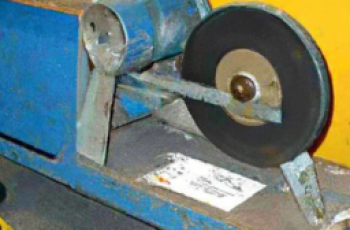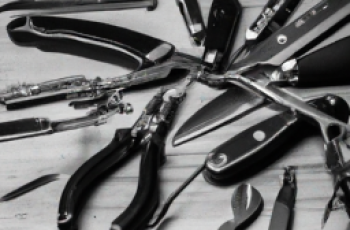Angle grinders are an indispensable tool in various industries, from construction to metalworking. However, these powerful machines often come with the downside of excessive noise. Fear not, as the solution to this problem lies in noise reduction technology specifically designed for angle grinders. By implementing these innovative noise reduction techniques, users can now enjoy a much quieter and more comfortable working environment without compromising on the grinder’s efficiency and effectiveness. Say goodbye to ear-splitting noise and hello to a more peaceful and productive work experience with noise reduction for angle grinders.
Noise Reduction for Angle Grinders
Angle grinders are powerful tools commonly used in various industries such as construction, metalworking, and woodworking. While they are efficient in cutting, grinding, and polishing materials, they also produce a significant amount of noise. This noise can have a negative impact on both the workers’ health and safety, as well as their productivity. In this article, we will explore the effects of angle grinder noise, the regulations and guidelines set in place to protect workers, the factors affecting noise levels, common noise reduction techniques, advanced strategies for noise reduction, as well as the importance of training and awareness.
Understanding Noise Pollution
Definition of Noise Pollution
Noise pollution refers to excessive or disturbing noise that can have harmful effects on human health, safety, and overall well-being. It is considered a form of environmental pollution, and it can originate from various sources, including industrial machinery and equipment.
Impact of Noise Pollution on Health and Safety
Exposure to excessive noise levels can have both short-term and long-term impacts on the workers’ health. The continuous exposure to high levels of noise can lead to hearing damage and hearing loss. Additionally, it can cause stress, fatigue, and impact communication and concentration, putting the workers’ safety at risk.
Sources of Noise Pollution in Industrial Settings
Industrial settings, especially those where angle grinders are used, can be major sources of noise pollution. The high-speed rotation and friction generated by angle grinders produce a significant amount of noise. Other sources of noise in industrial settings include motors, air compressors, and other machinery and equipment used for various tasks.
Effects of Angle Grinder Noise
Hearing Damage and Hearing Loss
One of the most significant effects of angle grinder noise is hearing damage and hearing loss. Prolonged exposure to high noise levels can cause irreversible damage to the delicate structures of the inner ear, leading to permanent hearing loss. This can have a profound impact on the workers’ quality of life, both in their personal and professional spheres.
Stress and Fatigue
Excessive noise levels can also result in increased stress and fatigue. The constant exposure to loud noise can cause psychological stress, leading to feelings of irritability, anxiety, and reduced ability to concentrate. Additionally, the physical strain associated with noise pollution can contribute to fatigue and overall decreased work performance.
Impact on Communication and Concentration
Noise pollution from angle grinders can make it challenging for workers to communicate effectively in the workplace. This can hinder teamwork, coordination, and overall productivity. Furthermore, the constant background noise can make it difficult for workers to concentrate on their tasks, leading to errors and potential accidents.
Regulations and Guidelines
Regulatory Standards for Noise Levels in Workplaces
To ensure the health and safety of workers, various regulatory standards and guidelines have been established to regulate noise levels in workplaces. These standards specify the permissible exposure limits (PELs) for noise in different industrial settings. Adhering to these standards is essential for employers to protect their workers from the harmful effects of noise pollution and prevent potential legal repercussions.
OSHA Guidelines for Angle Grinder Noise
The Occupational Safety and Health Administration (OSHA) provides guidelines specifically for controlling noise hazards in the workplace, including those related to angle grinder noise. These guidelines outline the responsibilities of employers in implementing noise control measures, conducting noise assessments, and providing workers with appropriate training and protective equipment.
Workers’ Rights and Employer Responsibilities
Workers have the right to a safe and healthy work environment, including protection from excessive noise levels. Employers have the responsibility to identify and assess noise hazards, implement effective control measures, and provide workers with the necessary training and personal protective equipment (PPE) to mitigate the risks associated with angle grinder noise.
Evaluation of Noise Levels
Measuring Noise Levels with Decibel (dB) Scale
Noise levels are measured using the decibel (dB) scale, which quantifies the intensity of sound. This logarithmic scale allows for a better understanding of the differences in noise levels and their potential impacts on human health. The higher the decibel reading, the louder and more damaging the noise.
Common Noise Levels Produced by Angle Grinders
Angle grinders typically produce noise levels ranging from 90 dB to 110 dB, depending on various factors such as the power and speed of the grinder, the material being cut or ground, and the condition of the grinder disc. These noise levels can be harmful, especially with prolonged exposure.
Factors Affecting Noise Levels
Several factors contribute to the noise levels produced by angle grinders. These include the power and speed of the angle grinder, the nature and hardness of the material being cut or ground, the quality and condition of the grinder disc, as well as the use of auxiliary noise control equipment.
Factors Affecting Angle Grinder Noise
Power and Speed of the Angle Grinder
The power and speed of the angle grinder directly impact the noise levels generated. Higher-powered grinders tend to produce louder noise, especially at higher speeds. It is important to consider the appropriate power and speed for the task at hand while keeping noise reduction in mind.
Nature and Hardness of the Material Being Cut or Grinded
The material being cut or ground by the angle grinder plays a role in the noise levels generated. Harder materials, such as concrete or metal, produce higher levels of noise compared to softer materials. Understanding the impact of different materials on noise can aid in selecting appropriate noise reduction techniques and controls.
Grinder Disc Quality and Condition
The quality and condition of the grinder disc can significantly affect noise levels. A worn-out or unbalanced disc can create vibrations and increase noise levels. It is essential to regularly inspect and maintain grinder discs to ensure optimal performance and minimize noise production.
Use of Auxiliary Noise Control Equipment
Employing auxiliary noise control equipment, such as specialized mufflers or silencers, can help reduce noise levels generated by angle grinders. These devices are designed to absorb or redirect the sound waves, effectively reducing overall noise output. Understanding the available options and choosing the appropriate equipment is crucial for effective noise reduction.
Common Noise Reduction Techniques
Using Low-Noise Angle Grinders
Using low-noise angle grinders specifically designed to minimize noise production is an effective noise reduction technique. These grinders are engineered with noise-reducing features such as sound-dampening materials, improved motor design, and vibration isolation, resulting in significantly lower noise levels without compromising performance.
Regular Maintenance and Inspection
Regular maintenance and inspection of angle grinders are essential for noise reduction. Proper lubrication, tightening of components, and replacement of worn-out parts can help prevent excessive noise due to mechanical issues. Implementing a maintenance schedule and training workers on proper grinder care can prolong the lifespan of the equipment and reduce noise output.
Proper Selection and Fitting of Grinder Discs
Selecting the appropriate grinder disc for the task at hand is crucial for noise reduction. Different discs are designed for specific materials, and using the right disc can minimize noise generation. Additionally, ensuring the disc is properly fitted and balanced helps reduce vibrations and resulting noise levels.
Personal Protective Equipment (PPE)
Providing workers with appropriate personal protective equipment (PPE) is a crucial aspect of noise control. PPE, such as earmuffs or earplugs, helps protect workers’ hearing by reducing the level of noise reaching their ears. It is essential to educate workers on the correct usage of PPE and ensure its availability and proper fit.
Advanced Noise Reduction Strategies
Using Noise-Reducing Discs
Noise-reducing discs, specifically designed to minimize noise levels during grinding and cutting operations, are an advanced noise reduction strategy. These discs are engineered with innovative materials and designs, effectively reducing noise without compromising cutting performance. Using noise-reducing discs can provide a significant reduction in overall noise levels.
Implementing Engineering Controls
Engineering controls focus on modifying or redesigning equipment and processes to minimize noise levels. This includes implementing noise-reducing modifications to angle grinders, such as adding sound-dampening materials, improving motor design, or incorporating advanced vibration isolation systems. Engineering controls can significantly reduce noise levels and create a safer and more comfortable work environment.
Enclosures and Soundproofing
Enclosing angle grinders or creating soundproof work areas can prevent noise from spreading to the surrounding environment. Installing soundproof enclosures or using barrier materials can effectively reduce noise transmission and protect workers and those in neighboring areas from excessive noise levels.
Vibration Isolation and Dampening
Vibration isolation and dampening techniques can help reduce noise levels generated by angle grinders. These techniques focus on minimizing or absorbing vibrations produced during grinding operations, which can contribute to increased noise. Implementing vibration isolation pads or mounts can effectively reduce overall noise output.
Training and Awareness
Educating Workers about Risks and Best Practices
Proper education and awareness among workers about the risks associated with excessive noise exposure are crucial. Workers should be educated about the potential health impacts of noise pollution and provided with information on best practices for noise reduction. This includes understanding the appropriate use of angle grinders, maintenance procedures, and proper usage of personal protective equipment (PPE).
Providing Noise Control Training Programs
Implementing noise control training programs can help workers understand the importance of noise reduction and learn effective strategies to minimize noise exposure. These training programs should cover topics such as selecting and using low-noise angle grinders, choosing the right discs for specific tasks, and utilizing proper maintenance techniques to reduce noise levels.
Raising Awareness on Noise-Related Health Issues
Raising awareness about noise-related health issues is crucial for fostering a safe and healthy work environment. Employers should actively promote the importance of noise reduction and educate workers about the potential long-term effects of excessive noise exposure. This can be done through campaigns, posters, and educational resources that emphasize the significance of protecting one’s hearing.
Conclusion
Noise reduction for angle grinders is a critical aspect of ensuring the health, safety, and overall well-being of workers in various industries. Understanding the impact of angle grinder noise, complying with regulatory standards and guidelines, evaluating noise levels, implementing noise reduction techniques, employing advanced strategies, and providing proper training and awareness are all essential steps towards creating a quieter and safer workplace. By prioritizing noise reduction, employers can protect their workers’ hearing, enhance productivity, and foster a positive work environment.



